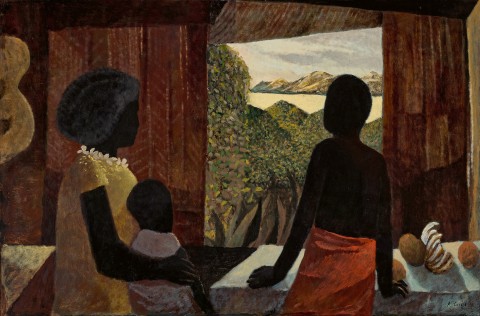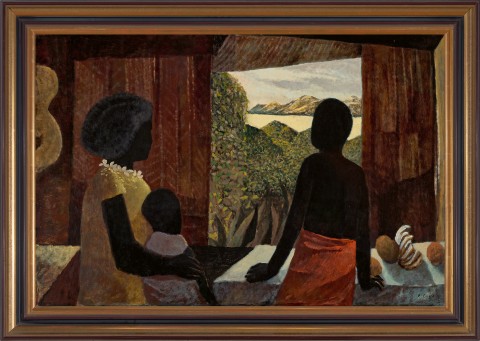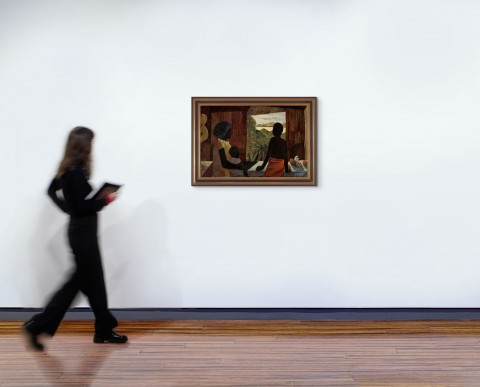FAMILY GROUP, THURSDAY ISLAND, 1962 – 63
RAY CROOKE
oil on composition board
60.5 x 91.5 cm
signed lower right: R. Crooke
signed and inscribed verso: THE ISLANDERS / R.CROOKE / YORKEYS KNOB /
further signed and inscribed verso: Island / Family / THURSDAY Is. / 1962.3 / Ray Crooke / Nov 00
Private collection, Perth
Leonard Joel, Melbourne, 4 April 2000, lot 252 (as ‘The Islanders’)
Savill Galleries, Sydney (label attached verso)
Private collection, Sydney
Ray Crooke, Savill Galleries, Sydney, 18 May – 10 June 2006, cat. 3 (illus. in exhibition catalogue)
Crooke, R., & Denham, P., Island Journal, Bede Publishing, Brisbane, 2000, p. 2 (illus.)
‘…Crooke’s paintings reveal a humility of attitude which does not seek the unusual but achieves it. If his paintings of Australia’s tropical North and the native people going about their simple daily tasks or sitting as monuments in the deep shadow of their huts, spell such an enchantment, it is because poetical truth is deeper than ordinary vision.’1
Drawing inspiration from a lifetime of experience living in Northern Queensland and the adjacent Melanesian islands, Ray Crooke is celebrated for his quiet but intensely evocative landscapes which emphasise the monumental simplicity and laconic grace of people shaped by their environment. Whether engrossed in daily rituals, glimpsed in the cool of shaded rooms or ensnared within webs of light and shade beneath jungle vegetation, his compositions bear a strong sense of locality, describing with unprecedented accuracy this remote region and the unique light that so distinguishes it. Significantly, the serene Family Group, Thursday Island, 1962 – 63 offered here belongs to the first dedicated body of work which the artist undertook following his return to Far North Queensland after successful exhibitions in 1957 and 1959 enabled him to leave Melbourne and settle in Yorkeys Knob where he could paint full-time. While appearing as ‘snapshots’ or portraits of a specific place, these compositions are nevertheless ‘the remembrance of things past’, emerging from the artist’s mind’s eye following the disciplined distillation of observed fact previously explored through studies and sketches. Encapsulating Crooke’s desire to create ‘a romantic form of expression based upon imagination and emotion’2, indeed such works give precedence to mood over action or narrative to examine, rather, the fundamental relationship between man and nature.
Fundamental to such conscious ordering of forms towards an aesthetic ideal is Crooke’s enduring preoccupation with tonal relationships, contours and silhouettes, and the dramatic juxtaposition of dark against light. Indeed, despite his richly decorative and highly developed sense of colour, one only need compare such tropical landscapes with those of his artistic predecessor, Paul Gauguin, to discern ‘the differences between an artist working through tone and one who worked through colour.’3 Underpinning the strength and authenticity of his vision, thus the image here is built up from a dark ground organised around tonal relationships to reveal a carefully constructed scene, with the three protagonists silhouetted against the soft dappled sunshine that streams through the window from the sparkling sea beyond. Imbuing the work with a powerful sense of mystery and curious timelessness, it is this sensation of clear defining light which gives stature to islander life and reveals Crooke’s abiding interest in the dignity of man. Betraying strong affinities with the art of Florentine Renaissance masters Giotto and Piero della Francesca in their quest to locate the eternal in the present moment – that point of intersection between time past and time to come – Crooke’s meditations accordingly invite his audience to experience the art of stillness, to appreciate the flow of time in its purest, most metaphysical sense. For, as James Gleeson astutely asserts, that ‘special kind of magic’ in Crooke’s paintings ‘only begins to work when one has discovered the stillness and the silence that lies at the heart of everything he paints... This stillness is not the mere stillness of arrested motion, but the projection of a mind preoccupied with deep and permanent things.’4
1. Langer, G., The Courier-Mail, Brisbane, 8 November 1967
2. Smith, S., North of Capricorn: The Art of Ray Crooke, Perc Tucker Regional Gallery, Townsville, 1997, p. 7
3. Gleeson, J., ‘Introduction’, Ray Crooke, Collins, Sydney, 1972, unpaginated
4. ibid.
VERONICA ANGELATOS


